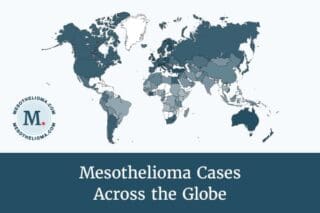
Jim Leonard was a devoted dad and grandfather, enjoying retired life on the golf course and going to as many sporting events as he could. Leonard would cheer on his grandchildren and his hometown team, the Franklin Wildcats, and was a devoted fan of the University of Tennessee, a team he got to know as a young boy before his family moved to Ohio.
“On Friday nights, you could find him at the football game in his reserved seat, or during basketball season, he was courtside rooting on the Cats!” Leonard’s daughter, Jenni DeHart recently recalled to Mesothelioma.com.
Leonard earned his retirement after working at a paper mill for 40 years to provide for their family. He was a loving father, and DeHart remembers herself and her two siblings having a wonderful home life. “Our parents raised us in a blue-collar home with a lot of love and a commitment to a strong work ethic and a devotion to family loyalty and small-town roots,” she said.
But this past May, what the family originally believed might have been a treatable case of the shingles turned out to be pleural mesothelioma.
Asbestos in the Workplace
An unfortunate reality for many Americans and workers around the globe is the heavy, though hidden, presence of asbestos in their workplaces. Researchers have even said as a result, asbestos is the number one cause of occupational cancer in the country.
Asbestos was a popular mineral for years because it was accessible and inexpensive, durable, and fire resistant. It was mined and used in thousands of products, from hair dryers to insulation and roofing. As such, many industries used asbestos in their equipment, in the buildings themselves, or even directly in the products they were making.
For Leonard working in the paper industry, he likely faced asbestos exposure from the construction of the paper mill and possibly the equipment he was using every day. Paper mills would often rely on asbestos for their drying machines or the talc and sandpaper backings they’d need. Talc has also been widely contaminated with asbestos, and may have been another means of exposure for these workers.
Though no amount of asbestos is considered safe, working in his industry for 40 years put Leonard at an even higher risk of exposure. Him and his family were unaware of the presence of asbestos at his job and the risk he was taking every day being there.
An Unexpected Diagnosis
It wasn’t until this year, after being retired for 17 years, that Leonard began to experience early signs of mesothelioma. DeHart recalls her dad complaining of chest pain, having very little appetite, and slowing down on the golf course. Though his doctor initially suspected shingles, a blood test showed that wasn’t the case. Leonard was then referred to a pulmonologist for further testing.
“The pulmonologist quickly suspected lung cancer after seeing the results of the scans. Dad resigned himself to the fact that it could be cancer, even mentioning ‘I think my golfing days are over,’” DeHart said. “But we were praying and hoping it was not. Dad wasn’t a smoker, so it couldn’t be lung cancer.”
As they waited for the news, the family saw their dad continue to grow weaker. He didn’t want to eat and would become winded even after taking only 10 steps. Leonard had fluid removed from his lungs twice, and in June he went into surgery for a a biopsy of the mass in his lungs. “Afterward, the surgeon told my sister, Suzanne and I, that he suspected it was stage IV mesothelioma. When the surgeon told my dad the next day that he suspected mesothelioma, all Dad said was ‘I knew a few guys who died from this.’”
A week later, the family officially received the news that their beloved father had advanced-stage mesothelioma. “Mesothelioma? The only thing my family knew of the disease is that we saw commercials about it from law firms,” DeHart explained to Mesothelioma.com. “We didn’t know anyone who had it. It wasn’t on our radar. We became educated with the disease very quickly.”
Facing Stage 4 Mesothelioma
In their research, DeHart and her family learned about the seriousness of this rare cancer. They were devastated to learn that not only could Leonard not be cured, but with his older age they’d be lucky if they would have him for another year. Stage 4 pleural mesothelioma is typically described as having spread throughout the body to other organs and the lymph nodes.
At this point, patients generally experience more noticeable and severe symptoms, and treatment focuses on helping to relieve these pains. With such an advanced stage of disease, even younger patients often only have palliative treatment as an option because the cancer has spread too far. Because of this, stage 4 mesothelioma patients have a life expectancy of about one year.
Leonard began palliative treatment shortly after receiving his official diagnosis. “He had his first and only chemo five days after his diagnosis. I remember the nurse telling him that day, the goal was not to cure, but to extend life. Dad handled that information like a champ, while I became sick to my stomach,” DeHart remembers.
Unfortunately, the chemotherapy didn’t have the results the family hoped for. Leonard faced strong side effects from the treatment, becoming bedridden, severely dehydrated, losing his appetite, and only wanting to sleep. DeHart describes her father’s decline as tragically being quite rapid.
“Two weeks after his first chemo, we had Hospice come into my parents’ home. On July 28th, three days after Hospice arrived, Dad passed away surrounded by his family. We prayed over him, and told him we loved him as he slipped away from us. He was 77 years old.”
The Need for Justice and Better Awareness
In the wake of their father’s tragic and untimely death, DeHart and her family want justice. As they had researched mesothelioma, they learned more about the dangers of asbestos and the bad business practices around the mineral. The family learned that not only did his career lead to his exposure and terminal cancer, but that many business executives were well aware of the dangers of the toxin and their employees facing exposure at work. But the costs and hassle of asbestos abatement and the presumed need to continue using asbestos in their products made many of these companies hold back.
DeHart explained to Mesothelioma.com that her family desperately wants to see change in these practices. “Our family is angry. The factory is long gone, yet we want justice served for the unnecessary and senseless death of our father. A man who worked many long hours in a hot paper mill to provide for his family.”
His death has, however, given the family purpose in advocating for mesothelioma and the ban of asbestos. They hope sharing his story will help raise awareness for the disease, and are actively looking for other ways to get involved in the fight to ban the deadly toxin for good.
“How can such a progressive country still be exposing its citizens to this deadly fiber?,” DeHart continued. “Our family will do whatever is necessary to make sure another family doesn’t lose a mother or father to a death resulting from asbestos exposure. We will miss our father for the rest of our lives, and what hurts the most is knowing his death was completely preventable. Our dad died at the hands of corporate greed, and someone must answer for his death.”




